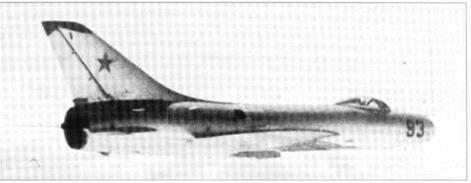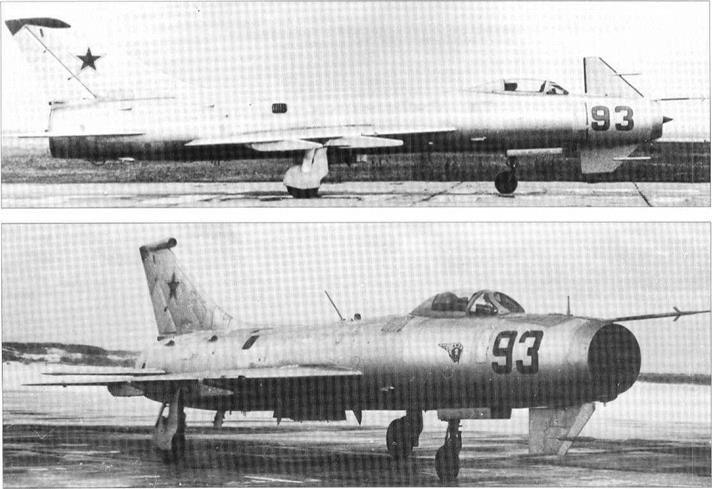. Sukhoi 100LDU
Purpose: To flight-test canard surfaces. Design Bureau: P O Sukhoi, Moscow
As explained in the history of the T-4, this enormous project required back-up research right across Soviet industry. The Sukhoi OKB
itself took on the task of investigating the proposed canard surfaces. As the only vehicle immediately available was a two-seat Su-7U, with a maximum Mach number of 2 instead of 3, the resulting aircraft – with designation 100LDU – ceased to be directly relevant to the
T-4 and became instead a general canard research vehicle. It was assigned to LIl-MAP test pilot (and future Cosmonaut) Igor Volk, and was tested in 1968-71.
The basic Su-7U, powered by an AL-7FI – 200 with a maximum afterburning rating of 10,100kg (22,282 Ib), was subjected to minor modifications to the rudder and braking- parachute installation, and was fitted with fully powered canard surfaces on each side of the nose. These were of cropped delta shape, with a greater span and area than those of contemporary experimental MiG aircraft, and with anti-flutter rods which were longer and nearer to the tips.
This aircraft fulfilled all test objectives, though the numerical data were of only marginal assistance to the T-4/100 design team.
SLIKHOI 02-10, OR L02-10

Purpose: To investigate direct side-force control.
Design Bureau: P O Sukhoi, Moscow.
In 1969 this Su-9 was modified for the LII, which wished to investigate the application of direct side force. The LII had been concerned at American research into direct lateral or vertical force which could enable a fighter to rise, fall, move left or move right without changing the aircraft’s attitude. In other words such an aircraft could keep pointing at a target in front while it crabbed sideways (for example). Testing began in 1972. In 1977 the aircraft was returned to a Sukhoi OKB factory and had the upper nose fin removed, testing continuing as a joint LII/Su programme. It was further modified in 1979.
Originally this aircraft was a production Su – 9 interceptor, though it never saw active service. In its first 02-10 form is had substantial vertical fins added above and below the nose. Each fin was pivoted at mid-chord and fully
powered. The pilot was able to cut the nose fins out of his flight-control circuit, leaving them fixed at zero incidence. When they were activated, movement of his pedals drove the fins in unison with each other and in unison with the rudder. The two canard fins moved parallel to the rudder, to cause the aircraft to crab sideways. Each surface was of cropped delta shape, with a lower aspect ratio than the horizontal canards of the S-22PDS. Compared with the lower fin the upper surface had significantly greater height, and it was mounted slightly further forward. Each was fitted with an anti-flutter rod mass,
which during the course of the programme was moved from 40 per cent offin height (distance from root to tip) to 70 per cent. After the 02-10’s first series of tests the upper nose fin was removed (leaving its mounting spigot still in place). Later a cine camera was installed on the fin to record lateral tracking across the ground, and in some of the later tests the wings were fitted with smoke nozzles along the leading edge, to produce visible streamlines photographed by a camera in a box immediately ahead of the radio antenna.
This aircraft generated useful information, but the idea has never been put into practice.
|











